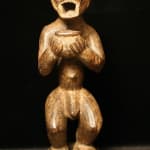Baule Mbra Monkey Sculpture, 20th Century CE
wood
21
DA.429 (LSO)
Further images
This striking sculpture is a Mbra monkey figure, carved by the Baule of the Ivory Coast. It is a tall artwork, standing on an integrated circular base. The figure has...
This striking sculpture is a Mbra monkey figure, carved by the Baule of the Ivory Coast. It is a tall artwork, standing on an integrated circular base. The figure has large feet with flexed legs, a straight back and arms flexed at the elbow, holding a circular rimmed vessel in the hands. The detailing is basic beneath the neck, with incised toes and fingers, a prominent navel, exaggerated male genitalia and lines demarcating limb joints. The head is traditional, yet carved with unusual gracility. It is longer than it is wide, with a prominent snout that runs from the dished face. The eye sockets are separated by a nasal ridge, each bearing a carved and polychromed eye. The teeth are bared on both sides, with the incisors and canines absent, lending the snout a tubular aspect. The wood is comparatively light-coloured, with a natural gloss.
The monkey is called “Mbra” (or Gbreke), and is a potent symbol for the Baule. Full-sized versions of this creature are often stood up in Baule villages and are used to assist in divination rituals. They are considered so powerful that women are not allowed to see them. Their fearsome appearance is boosted by the application of encrusted patinas that are the result of repeated libations of dog blood (dogs are usually sacrificed to this end).
The Baule live across the Ivory Coast area, and have an economy based primarily on sedentary agriculturism. They have thus been able to build up a considerable political and economic stronghold, which has in turn given rise to a strong ritual and artistic heritage. Their own creation story relates to an ancient migration, in which the queen was forced to sacrifice her son in order to ford a mighty river. So upset was she that all she could say was “baouli” (“the child is dead”), thus giving rise to the tribe’s name.
Blolo bian (male) and Blolo bla (female) spirit spouses are perhaps the Baule’s greatest artistic and psycho-social achievement. These figures are otherworldly partners for young men and women, and are designed as perfect women/men who provide spiritual assistance to their earthly spouses. The Baule are also known for sculptures representing bush spirits (Asie usu) – mischievous and potentially malevolent inhabitants of the “bush”, or dark country beyond the boundary of the village – monkeys, and three types of masks that are used in the celebration of good harvests, mourning, and the visits of important dignitaries.
This is an outstanding example of the Baule magical tradition.
The monkey is called “Mbra” (or Gbreke), and is a potent symbol for the Baule. Full-sized versions of this creature are often stood up in Baule villages and are used to assist in divination rituals. They are considered so powerful that women are not allowed to see them. Their fearsome appearance is boosted by the application of encrusted patinas that are the result of repeated libations of dog blood (dogs are usually sacrificed to this end).
The Baule live across the Ivory Coast area, and have an economy based primarily on sedentary agriculturism. They have thus been able to build up a considerable political and economic stronghold, which has in turn given rise to a strong ritual and artistic heritage. Their own creation story relates to an ancient migration, in which the queen was forced to sacrifice her son in order to ford a mighty river. So upset was she that all she could say was “baouli” (“the child is dead”), thus giving rise to the tribe’s name.
Blolo bian (male) and Blolo bla (female) spirit spouses are perhaps the Baule’s greatest artistic and psycho-social achievement. These figures are otherworldly partners for young men and women, and are designed as perfect women/men who provide spiritual assistance to their earthly spouses. The Baule are also known for sculptures representing bush spirits (Asie usu) – mischievous and potentially malevolent inhabitants of the “bush”, or dark country beyond the boundary of the village – monkeys, and three types of masks that are used in the celebration of good harvests, mourning, and the visits of important dignitaries.
This is an outstanding example of the Baule magical tradition.









